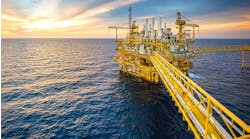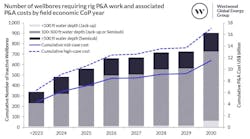Greater Warwick Area wells to test for giant, connected basement oil field
Offshore staff
GODALMING, UK – Hurricane Energy and new partner Spirit Energy expect to initiate drilling on the Greater Warwick Area (GWA) west of Shetland next month, after EnQuest has released the semisubmersible Transocean Leader.
The campaign will begin with the Warwick Deep well, the first horizontal producer Hurricane has drilled outside local structural closure. This will include a test to assess the productivity of the deeper fracture network, providing more evidence of oil mobility within the basement reservoir.
Hurricane based its geological model for the GWA on drilling and testing results from the Greater Lancaster Area (GLA), Whirlwind, and Lincoln basement wells.
The company believes that the seismically mapped faults that subdivide the GWA into the Lincoln and Warwick oil volumes represent high permeability features rather than reservoir barriers.
If that is the case, the GWA will likely prove to be a single supergiant field rather than separate hydrocarbon accumulations.
In order to test this geological model, all three of this year’s wells will be suspended with downhole gauges, providing a means for visualizing subsequent GWA well tests.
In addition, the planned single-well tieback to theFPSOAoka Mizu for the forthcoming GLA early production system (EPS) will provide the option to undertake interference trials.
These, combined with a further three horizontal producer wells, will assist planning for the initial stage of the GWA full-field development. Hurricane expects installation and completion to follow in summer 2020, followed soon afterwards by first oil.
For theLancaster EPS development, the offshore construction vessel Far Superior placed enhanced horizontal xmas trees in the Lancaster 6 and 7Z wells, with Transocean’s semisub Paul B. Loyd, Jr. rig undertaking the well completions.
This operation included installation of dual-pod electrical submersible pumps (ESPs) in each well. Hurricane expects the EPS to reveal the extent to which ESPs are needed to enhance natural flow to the targeted production levels.
They should also provide data to improve understanding of the Lancaster reservoir.
Recently the FPSO was hooked up to the turret mooring buoy and commissioning work is under way ahead of first oil.
Hurricane and Bluewater used downtime during the previous two hookup attempts to progress pre-commissioning, where possible. The company will take care to bring each well online individually in order to maximize the reservoir data.
Spirit’s farm-in last year provides up to $387 million for a phased work program leading to an initial full-field development of the GWA.
The resultant acceleration in appraisal and development of the GWA will bring forward a potential final investment decision on a full-field development here by several years, Hurricane said.
In readiness work has started on reinstating the gas compression system on theAoka Mizu and a tie-in to the West of Shetland Pipeline System to evacuate the GLA and GWA associated gas.
Subject to regulatory approval, this will allow the partners to use the full 30,000 b/d throughput capacity on the FPSO. Debottlenecking studies are also progressing to potentially increase throughput to 40,000 b/d.
03/28/2019


